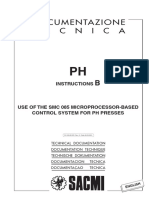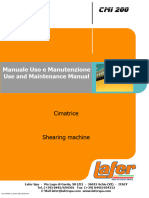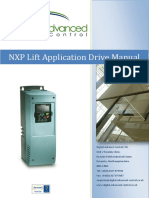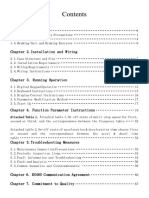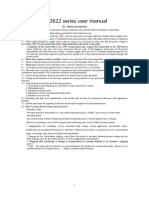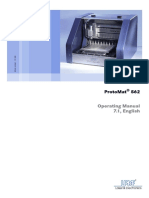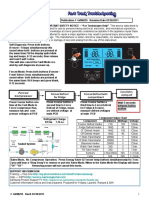PCB LOADER &
UNLOADER
MANUAL
*Please be sure to read through this manual carefully before use to ensure proper use of the
product.
� We are grateful to you for purchasing our products. This manual explains the
composition of the hardware, equipment operation, electrical diagrams and
maintenance. Please fully understand the contents of this manual and use it
correctly.
Warning:
This equipment should only be operated by professional
maintenance and repair personnel or trained personnel.
Before turning on the power, please make sure that the
external input power matches the rated voltage and power of
the equipment.
Please ground the equipment reliably.
All mechanical drives of this equipment should be operated
with personal safety in mind.
Attention:
Please read this user manual carefully before operating this equipment,
and remember the precautions
Please do not install this equipment near sources of electromagnetic
interference
Do not modify the hardware and software programs in the electrical box,
it is dangerous to do so.
Please keep this manual in a safe place and maintain the equipment
according to the requirements of the manual.
ii
� CONTENTS
Chapter 1:Introduction........................................................................................................................................ 1
1.1 General ................................................................................................................................................................. 1
1.2 Technical parameters ......................................................................................................................................... 2
Preparation for use .....................................................................................................................................................3
Chapter 2: Machine Operation .........................................................................................................................4
2.1 Start-up Precautions ........................................................................................................................................... 4
2.2 Operating instructions .........................................................................................................................................4
2.3 Signal description ..........................................................................................................................................................5
Chapter 3: Troubleshooting............................................................................................................................. 7
Chapter 4: Maintenance ............................................................................................................................. 8
iii
�Chapter 1: Introduction
1.1 General
For use on boards in SMT production lines.
Features of this machine:
Adopts Panasonic PLC and precision stepping.
1
� 1.2 Technical parameters
Items Main parameters
PCB Direction L-R / R-L
Power Supply AC220 50/60Hz 300W
Control Mode Touch screen + Panasonic PLC control.
Transmission type belt conveyor
PCB Thinckness 0.7-30mm (Customized)
Conveying height Customized
User P a s s w o r d : 123 (minimum authority)
Engineer P a s s w o r d : 1234
Manufacturer P a s s w o r d : 512212(highest authority)
2
�Preparation for use
Please use 220V single-phase 50Hz fixed power supply
with a capacity of 200W or more.
The machine must be safely earthed and connected to
the earth bus (electronics)
The ground wire must be well secured to a metal part
of the machine.
For safety reasons, do not place your body close to
the machine in operation.
Do not install the machine in dusty, oil mist,
conductive dust, corrosive gas, flammable gas, humidity,
shock and vibration, strong interference, high
temperature and outdoor environment.
Avoid using corrosive solvents to wipe the machine,
use neutral cleaners.
Please keep this manual for future maintenance and
repair.
Attention:
There is no reliable grounding and there may be a risk of electric shock.
3
�Chapter 2: Operation of machines
2.1 Start-up Precautions
1. To ensure safety, no body contact with running parts is allowed
2. Check for debris in the machine.
3. Detect any debris or PCBs on the track.
2.2 Operating instructions
2.2.1 Power-up display page (Figure 1 below)
4
�Figure 1
5
�Page Introduction: This page is the initial display page of the touch screen after
the device is turned on, the page shows the name of the device and the contact
information with us.Click "ENTER" to the main menu. Shows as Figure 2.
2.2.2 Main menu page (Figure 2 below)
6
�Figure 2
7
� Explanation
AUTO——Clicking the button switches the screen to the "Automatic
Operation" page.
You can start the automatic operation of the device and monitor the
information of the automatic operation of the device.
Parameter ——After clicking the button and entering the correct password, the
screen page switches to the "Parameter Setting" page, where you can set the
operating parameters of the device.
IO ---Clicking the button, the screen page switches to the "IO Monitoring" page,
which allows you to monitor the sensors and movements of the equipment.
Alarm --Click the button, the screen page switches to the "Alarm View" page,
you can view the alarm information of the device.
Manual ---Click the button, the screen page switches to the "Manual Operation"
page, you can manually operate the action of each structure.
Exit--Returns to the startup page.
8
�2.2.3 Automatic operation page (Figure 3 below)
9
�Page Introduction: This page allows users to start and stop the operation of the
equipment, the production cycle, the number of products produced, the current
width of the equipment, alarm information view, switch mode.
Explanation
-Click on this to bring up the other screen shortcut button to quickly
go to the other screen.
The current circle S- - Displays the current PCB pass cycle.
Current Production number--Current production quantity.
Counter Reset-Click the button to clear the current production
quantity.
Standby--Displays the current machine operation status.
- - Click this button to toggle the board loader mode / board
sucker mode.
--This column displays the current alarm information of the machine
Stop- - can stop the device, leaving the machine in a stopped state
Reset--When the device is running alarm, click the button to clear the
alarm after handling the abnormality.
10
� Auto start- - Click this button the machine enters the automatic mode.
Back--Returns to the main page.
2.2.5 Parameter setting page (Figure 5 below)
11
� Figure 5
This page allows users to set various parameters for the operation of the equipment.
Explanation
Launch timeout--Alarm will be raised if the actuator has not sensed the actuator
in place sensor bit after the actuator has been pushed out for more than the set
time.
Return timeout——If the pusher does not return to the home position after the set
time has elapsed, the sensor will alarm.
Conveyor timeout setting——An alarm will be generated if the track transfer
does not stop after a certain amount of time has elapsed.
Out board Interval——The delay time after the track is out of the board.
12
� Initial push layer 9 Layer——Initial pusher level setting for the frame (e.g., enter 2
to start pushing plates from the second level of the frame).
rack induction delay——When switching the frame lift stop frame according to
this parameter stop frame (parameter cabinet please do not modify arbitrarily).
Frame out delay time——Out of frame time setting (the CY will stop running if the
set time is exceeded when the box is out of the box, and the value can be
increased appropriately according to the length of the CY).
250 Magazine- - Toggles the frame buttons.
Manufacturer's parameter-Enters the manufacturer's parameter page
(enter the manufacturer's parameter when entering the parameter
page this button will be visible).
2.2.6 IO Monitoring Page (Figure 6 below)
13
�Figure 6
14
�Figure 7
15
�Page description: This page monitors the input and output ports of the
equipment's PLC (this page can be used to check the operation of
electrical components and troubleshooting).
2.2.7 Alarm View Page (Figure 11 below)
16
� F i g u r e 11
Page Introduction: This page can view the alarm information, press the touch
screen alarm reset to clear the alarm.
2.2.8 Manual operation page (Figure 13 below)
17
� F i g u r e 13
Page description: Perform manual operation of each part, step setting of
the upper board machine part (this page needs to be operated in non-
automatic and non-alarm mode)
18
� Explanation
Reset——When the device is running an alarm, click the button to clear the alarm
after handling the exception.
One click out magazine——Clicking the button when there is a frame in the elevator
will automatically exit the frame.
Lift up——Click the button elevator rises one step.
Lift down——Click the button elevator tap to lower (tap action, need to keep
clicking).
Push out——Click the button to push the lever out
Lower limit——Lift table lifts to frame-in position
Upper limit——Lift table lifts to out-of-frame position
Magazine in——Manual frame entry of the lift table (the lift table needs to be in the
frame entry position for the action to work).
Magazine out——The lift table is manually out of the frame (the lift table needs to be in
the out-of-frame position for the action to take place).
Clamp magazine——Lift table clamping frame cylinder action.
Step—Continuously click on the button to toggle the up-board machine pusher
—step.
19
�2.2.10 Outgoing length setting screen (Figure 14 below)
20
�Page Introduction: This page is the manufacturer's parameter page (the
parameters of this page can not be set arbitrarily, which may cause operational
failures)
Explanation
Auto Start——Click on the button device startup.
Aging——Open the aging program.
Password modification——Go to the Parameter Modification page.
Frame delay time——Into the frame teleportation stops after exceeding the
time.
21
�Chapter 3 Troubleshooting
3.3.1 The following must be done to deal with malfunctions and repair equipment:
1. familiarize themselves with the principle and
electrical schematics of the equipment.
2. familiarizes himself/herself with the installation
position of each mechanical device and electrical
original in the equipment, and understands its
performance and function.
3. locate the faulty part and the component that
has malfunctioned
Chapter 4 Maintenance
22
� each week
Check that the transport belt is not too
l oose and keep the belt clean.
Wipe off any dirty oil with a non-woven
cloth or paper, then lubricate the ball screw.
Test for smooth product transfer.
Check belt tracks for wear.
Lubricate the screws at least once every 2
weeks.
Chapter 5: Wiring Diagrams
23
�24
�25
�26
�27
�28
�29
�30
�31
�32
�33
�34












